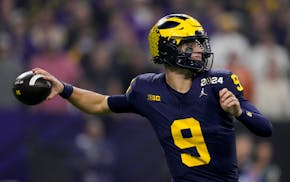FORT MYERS, FLA. - Before we start chronicling their failures during the marathon regular season, we should recognize that Major League Baseball showcases an elite subset of the world's best ballplayers, people of remarkable skills.
Not many of them seem to have developed those skills by hiring personal coaches or playing organized ball. For many big-leaguers, the best training facilities were back yards and basements, and the optimal coaches were best friends and fathers.
Growing up in the Vancouver area, Twins first baseman Justin Morneau would spent half the year playing hockey, the other half baseball. His father had a hitting cage at his office, and Morneau spent even more time playing 2-on-2 baseball in his backyard.
"We played a lot of whiffle ball," he said. "We played home run derby in my backyard. Over the porch was a home run. It was short to left field, so you tried to hit it the other way. If [the ball] went between the wood slots on the porch, that was a ground-rule double. Left field, we called the Green Monster, because it was these huge, 80-year-old trees.
"Hitting is repetition, and figuring things out on your own. It's hard to make adjustments if you don't know your own swing, if you always had a coach telling you what to do. We'd pretend to be Griffey, Olerud, Larry Walker, guys you'd see on TV, and my swing developed off of that.
"I played more whiffle ball and tennis ball games down at the school than actual baseball games, and I think that was good."
Catcher Mike Redmond didn't even have to go outside to learn his position.
"My twin brother and I used to play in the living room, and this was even before I started catching," he said. "One of us was the catcher and one was the guy running home from third. My dad would throw home and short-hop it, and if you were the catcher, you had to take the hit, make the tag and hold on.
"My brother would plow into me and I'd have to get him out. It tested your toughness, and sometimes, of course, it ended in a scrap. We did it on carpeting, in front of the fire place. And when we started playing organized ball, we knew how to play the right way. We never let up, from Tee ball on up."
Now Redmond is a catcher who plays despite gashes in his head and bruises all over his body. His brother?
"He's in the health business, running some surgery centers," Redmond said.
Of course.
Reliever Pat Neshek grew up in Brooklyn Park, playing in yards and sandlots with kids who would go to the Little League World Series.
"We had a sandlot-type yard, a corner lot, and we played every day after school," he said. "Our yard was so beat up, before we sold the house, we had to re-sod the whole thing.
"That was the year they went to the Little League World Series, and eight kids from our neighborhood were on that team, so I think it had a big impact on their skills. We kept stats, on a computer. I was the statkeeper, and we had an All-Star game. We even had nicknames.
"You'd have ghost runners, and you'd shut down an outfield, so you could play with any number of people. I think just playing every day was a big key to developing athletic ability, because all the kids who played with us were good in other sports, too."
Morneau had trees representing the Green Monster.
"Our neighbor's house was the Blue Monster," Neshek said. "We knocked windows out. We had to go to rag balls, but we still broke windows."
Catcher Joe Mauer and his brothers played in the family yard, as well as fields and parks around St. Paul.
"We played a lot of whiffle ball," Mauer said. "Any place we could find and ball we could find, we'd start a game. Games would break out in the house, too. Mom didn't like that too much.
"We'd play hot box down in the basement, or we'd do the Quickswing down there."
That device, which drops a small whiffle ball into the strike zone and encourages a compact swing, became The Mauer Quickswing, a portable hitting trainer, and helped create the swing of the 2006 American League batting champ.
"We'd just invent games to play," Mauer said. "I think that's changed, with so many kids playing video games. But video games can be learning tools, too, helping with game situations."
Playing Halo 3, though, probably isn't as good for hand-eye coordination as hitting a whiffle ball thrown by your neighbor, or as sure a developer of toughness as getting flattened by your brother in front of the fireplace.
Harmon Killebrew's mother once lamented that her sons were tearing up the yard. Harmon's father responded, "We're raising boys, not grass."
Accepting dead sod and broken windows might be the best way to raise a ballplayer.
Jim Souhan can be heard Sundays from 10 a.m.-noon on AM-1500 KSTP. jsouhan@startribune.com

Souhan: Wolves fans made Game 1 special. Now bring on Game 2.

Souhan: Should Vikings even consider McCarthy in NFL draft?

Souhan: NAW erases Suns' lead, Game 1 advantage with big performance

Souhan: This is KAT's chance to prove Flip Saunders was right

